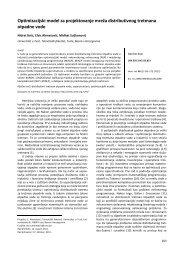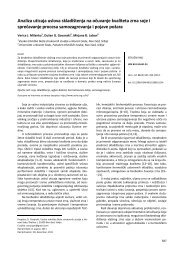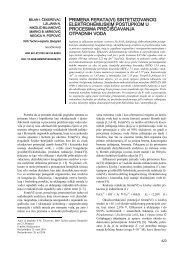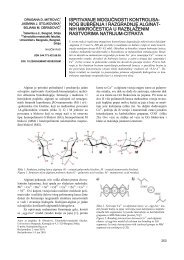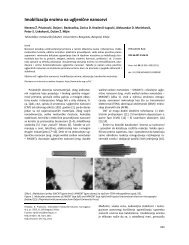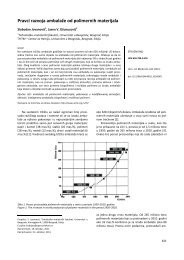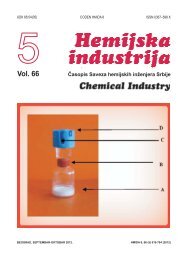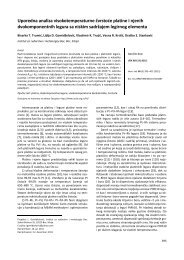HPLC, UV–vis and NMR spectroscopic and DFT ... - doiSerbia
HPLC, UV–vis and NMR spectroscopic and DFT ... - doiSerbia
HPLC, UV–vis and NMR spectroscopic and DFT ... - doiSerbia
Create successful ePaper yourself
Turn your PDF publications into a flip-book with our unique Google optimized e-Paper software.
Z.S. MARKOVIĆ et al.: CHARACTERIZATION OF PURPURIN ISOLATED FROM R.tinctorum Hem. ind. 67 (1) 77–88 (2013)<br />
to have the TEAC value of 1.950±0.008 mM. This result<br />
is in agreement with that reported [57], <strong>and</strong> indicates<br />
that purpurin has a good antioxidant activity.<br />
There is no detailed description of the radical cation<br />
of purpurin in literature. The radical cation formed by<br />
removing an electron from 1, Figure 2, is planar, <strong>and</strong><br />
hydrogen bonds are retained as in the parent molecule,<br />
contributing to further stabilization. The obtained value<br />
for the ionization potential (744.2 kJ/mol) of 1 is higher<br />
than the corresponding values for flavonoids [25], but<br />
is lower than the corresponding values for emodin <strong>and</strong><br />
lichexanthone [52,53]. On the basis of the ionization<br />
potential value, stronger antioxidant activity of purpurin<br />
than that for emodin <strong>and</strong> lichexanthone can be<br />
expected.<br />
It is well known that there is good correlation<br />
between antioxidant activity <strong>and</strong> BDE values [25,52].<br />
For this reason, the values of BDE for the OH groups of<br />
purpurin were determined. The obtained results (Table<br />
2) show that 1-OH <strong>and</strong> 2-OH groups are responsible for<br />
the antioxidant activity of purpurin. The BDE value for<br />
homolytic cleavage of the 1-OH bond is higher than<br />
those for dissociation of the OH groups in fisetin [58],<br />
<strong>and</strong> particularly in quercetin [25,26]. On the other h<strong>and</strong>,<br />
the obtained value is lower than the corresponding value<br />
for emodin [52].<br />
In the text below, some properties of the radicals,<br />
formed by homolytic cleavage of the OH groups of purpurin<br />
will be discussed. Geometry optimization of the<br />
radicals was performed by starting from the optimized<br />
structure of the parent molecule 1, <strong>and</strong> removing a<br />
hydrogen atom from the OH groups at positions 1, 2<br />
<strong>and</strong> 4. In the further discussion, the radical formed by<br />
H-removal from the x-OH group of purpurin is called<br />
the x-OH radical (x = 1, 2, or 4), for example 2-OH radical.<br />
Since the BDE value for 4-OH radical is significantly<br />
higher than that of 1-OH radical by almost 40<br />
kJ/mol, only 1-OH, <strong>and</strong> 2-OH radicals will be further<br />
considered.<br />
Inspection of the geometries of the obtained radicals<br />
shows that they retain planarity, like the parent<br />
molecule. Inspection of Table 3 allows further comment<br />
on the electronic structure of both radicals. In<br />
both radicals, complete delocalization involves only<br />
ring A, while ring B is characterized by three double<br />
bonds in 1-OH radical (C1-O, C2-C3, <strong>and</strong> C11-C12), <strong>and</strong><br />
by two double bonds in 2-OH radical (C2-O <strong>and</strong> C3-C4).<br />
On the basis of these structural features of the radicals,<br />
it is clear that delocalization between rings C <strong>and</strong> B is<br />
restricted. A consequence of the restricted delocalization<br />
is the decreased stability of both radicals, implying<br />
that their BDE values are slightly higher in comparison<br />
to those obtained for the majority of the flavones<br />
[25,26,57].<br />
84<br />
To underst<strong>and</strong> the relationship between the electron<br />
delocalization <strong>and</strong> the reactivity of a radical, the<br />
electron distribution in the singly occupied molecular<br />
orbital (SOMO) needs to be examined. The SOMO of<br />
the 1-OH radical (Figure 5) is mainly delocalized over<br />
carbonyl groups. As SOMO is the α-highest occupied<br />
molecular orbital, it does not describe the global electronic<br />
behavior of the radical, <strong>and</strong> its shape is not a<br />
reliable indicator for the reactivity of the purpurin radical.<br />
Figure 5. SOMO <strong>and</strong> spin density of the 1-OH radical.<br />
Spin density is often considered to be a more realistic<br />
parameter, <strong>and</strong> provides a more reliable representation<br />
of the reactivity [54]. The importance of spin<br />
density for the description of flavonoids has been<br />
pointed out in the papers of Leopoldini et al. [25,26],<br />
<strong>and</strong> Marković et al. [36,52,53]. The lower the BDE value,<br />
the more delocalized spin density in the radical,<br />
<strong>and</strong> easier radical formation are. As this consideration<br />
can be applied to antraquinones, the spin density in the<br />
purpurin radical was analyzed. The spin density distribution<br />
in the 1-OH radical indicates the oxygen atom<br />
bonded to C1 as the most probable radical center, followed<br />
by the adjacent carbons C2 <strong>and</strong> C11, <strong>and</strong> nonadjacent<br />
carbons C4 <strong>and</strong> C12 (Figure 5). Weak delocalization<br />
of the spin density exists over the ring C.<br />
The OH groups of purpurin can also undergo ketoenol<br />
tautomerism. Hydrogen atom from 1-OH position<br />
can migrate to positions 2 or 11, thus yielding two tautomers<br />
(Scheme 1). The BDE values for the formation<br />
of the 1-OH radical by H-abstraction from the C2 <strong>and</strong>




